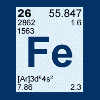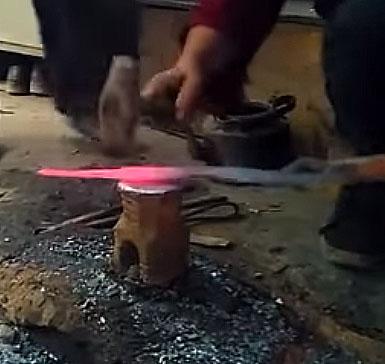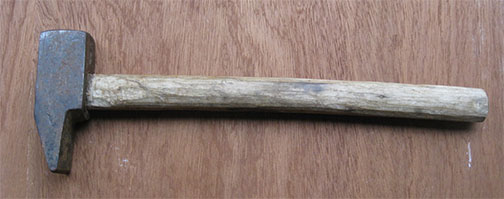-
Posts
381 -
Joined
-
Last visited
Content Type
Profiles
Forums
Articles
Gallery
Downloads
Events
Everything posted by caotropheus
-
"Got me self a new toe nail clipper!" At the packing house I worked a few years ago, the guys from the maintenance department called me and told me to take this guillotine before the arrival of the scrap metal people. Before they hang up the phone, I was already there! The ruler is 60 cm. It was made in Israel by a local manufacturer and has nice features even to cut 90 degrees corners in plate. It weighs above 100 kg. A die with different sets to cut different materials like angle iron T iron, square and round stock. It cuts plate up to 10 mm thick. What I do not understand is what is the symbol for the 12 mm ... probably you guys can help me on that. Thanks
-
Lots of Fun to watch https://www.youtube.com/watch?v=VG8QRSvIuPM And the ASO did not break...
-
https://www.bbc.com/news/world-europe-45753455 I am most curious to see what research will tell us about the metallurgy and materials the manufacturers used to make this sword, what was their raw material origin, what was the environment this sword was made, landscape, lake depth and so on, and so on ...
-

A collection of improvised anvils
caotropheus replied to Charles R. Stevens's topic in Anvils, Swage Blocks, and Mandrels
HojPoj, How heavy is the hammer head? This is the anvil used in Nepal https://www.youtube.com/watch?v=LmTHEmol9k0 I thought on taking a heavy hammer head (like a 8 kg or 10 kg) to make the main body of an anvil, take a bit of round stock, rivet this stock into the hammer eye and by stock removal, shape a horn out of it...Fun project for a couple of guys with sledge hammers. -
Steven511 Sorry that I am late...If you're looking for inspiration on anvil build go to Youtube and search videos with the following key words "homemade", "DIY", "Build", "Fabrication" plus key word "Anvil" and you will get dozens of very inspiring videos. First anvil I built was only edge welded and with time (and several thousands of blows) welds broke and anvil come apart. The first welds to break were the ones securing the top plate...
-

A collection of improvised anvils
caotropheus replied to Charles R. Stevens's topic in Anvils, Swage Blocks, and Mandrels
I made a mild steel anvil and improved greatly the rebound by laying an hard face to it. https://www.youtube.com/watch?v=d1-gk6W5Qrs Rebound test at 15:43 -
Got this "antique" french type hammer (750 grams) for 4 € at the flea market in a "collectors" configuration !!!!...
-
And what exactly is the number he is asking for the vice?
-
Because it is broken probably you can get it for less than 50 USD...Use the broken bit as leverage for your negotiation. If you repair it I think it is a perfectly functional vice.
-
Hard to say, what is the vice's condition, do you have pictures?
-
The counterweight of a tractor in upside down position. It was offered to me by the guys in one of the orchards where I work. The frame is 250 mm wide and built from 10 mm thick steel plate. The frame is salvageable to make the base for a bench grinder or a vice or something like that. The two counterweights are made of 50 mm thick plate dimensions 315 mm X 280 mm at the widest and 250 mm at the shortest. Interesting those counterweights look more and more like a swage block...
-
I suppose the answer to your question is in basic physics of metal quenching. Quenching in tea may be the same as quenching in coffee, or chamomile, right? But might be a difference according to the amount of sugar you dissolve in the tea! Actually quenching imposes speed in metal cooling and this speed depends on liquid viscosity liquid density, liquid heat conductivity (water vs oil, composition of different oils) and eventually liquid density. This brings me back to the tea with sugar! One of the quenching medias is water + dissolved salt. In other words, water + dissolved solid. You can read several threads here in the Forum about quenching medias, so I am not going to enter in details. If you dissolve solids in water like salt, it is going to change quenching speed, so dissolving a solid like sugar, sure is going to affect quenching speed. Sugar is more expensive than salt, so, I am not sure there were a lot of people willing to spend money to try it, even though you can make your media more dense with sugar when comparing with salt. So if you are willing to try water + sugar media for quenching it may be interesting and tell us the results. You can try soft drinks, honey, molasses, light solutions of sugar, dense solutions of sugar, what ever you wish. Now, I doubt you can make a solution of tea by it self that is dense enough to affect basic water quenching properties!
-

homemade anvil - an exercise of stubbornness
caotropheus replied to caotropheus's topic in Anvils, Swage Blocks, and Mandrels
Actually I am Portuguese ...My English is better than my Hebrew ...Even though I can read Hebrew...Like a 2nd grade child!!!... -

homemade anvil - an exercise of stubbornness
caotropheus replied to caotropheus's topic in Anvils, Swage Blocks, and Mandrels
Thank you very much for your kind words Gentleman. Sorry for torturing you with my broken English. -

homemade anvil - an exercise of stubbornness
caotropheus replied to caotropheus's topic in Anvils, Swage Blocks, and Mandrels
Finally, I finished the project https://www.youtube.com/watch?v=d1-gk6W5Qrs -

Portable hole / drifting block
caotropheus replied to CactusBob's topic in Anvils, Swage Blocks, and Mandrels
Either design of the block is OK. From my point of view, the way you plan the support, makes it a bit flimsy. I think you need a support the type of a anvil or striking anvil stand. Three legged support or on top of a I beam like VaughnT said or on top of thick wall pipe... The idea is to have a support that will transfer energy of the impact directly into the floor. Not a support energy will be transferred sideways, creates a shearing force that cause side support failure. -

Portable hole / drifting block
caotropheus replied to CactusBob's topic in Anvils, Swage Blocks, and Mandrels
Nice idea. I have to do something similar to use with my "light portable blacksmithing station" stand/leg vise/rail anvil/portable hole/drift block. I think you need a more sturdy support for your construction. -
I agree. Often you will find flypresses in the most unexpected places like in factories that pushed the flypress to the corner of a yard because they have a more modern hydraulic press, or in a garden of a private house because they are "beautiful". Sometimes people toss these presses outdoors and there they stay exposed to the weather for many years. I got my first flypress (3 ton) in a junk yard for about 50 USD. People just do not know what these machines are and if the press is covered in rust and muck, they are very easy to restore. I would suggest you ask around factories in your area, you may find a press cheap and they may even be very happy you remove it from the yard for them...
- 9 replies
-
- flypress press
- press
-
(and 2 more)
Tagged with:
-
Steel of course, my preference. Actually you can use what ever resources and tools you have. What is important is that the vice is firmly secured, the stand does not bounce and rock around when you work with the vise. good luck...
-
The issue of anvil rebound and how important it is pops up in the forum once in a while. Empirically, I noticed that when made my rock breaker chisel anvil (up right position, 120 kg weigh, impact resistant steel, heat treated from the factory, rebound above 90 %) metal would move much faster in comparison with my previous 50 kg lump of steel (I improvised as an anvil, rebound about 60%). So, my empirical conclusion was, better rebound will move metal faster. A more convincing answer may be obtain with a more controled experiment. 1. Lets set two bits of metal (anvil), same steel, same weight , same dimensions, one heat treated to anvil hardness, the other annealed. 2. Lets set drop hammers above those anvils, same weight, same face dimension, same guides, same lubrication, same height from the anvil surface. 3. Lets warm up to the same temperature two bits of steel the same dimensions and mass 4. Lets firmly secure (so more energy is used in forging and not movement) the two bits of steel on the surface of the anvil and lets drop the hammers 10 times at the same time for every drop 5. Let the samples of forged steel cool down and measure with a caliper or even a micrometer deformation 6. Lets repeat the same experiment 10 times 7. Lets make an average of metal deformation for the harden anvil and for the annealed anvil Unfortunately I do not have the resources to do this experiment. It may happen that gains obtained in metal deformation by a good rebound anvil is lost by the blacksmith (anvil not secured enough, metal slide on impact, metal deformation in other area that is not intended, etc). It may happen that anvil rebound is important at human level but at the power hammer is not so important. And the discussion can go on and on and on...
-

A collection of improvised anvils
caotropheus replied to Charles R. Stevens's topic in Anvils, Swage Blocks, and Mandrels
I agree with CR Stevens, use silicone and the steel block will stay attached to the wood base for a long time. I would hurry and improvise anvil #2 with the bit of rock breaker. I know it has a round section but you have a flat top surface. You will see the high rebound and how fast steel moves on top of rock breaker steel. Even though I have a real anvil, I keep on giving preference to my rock breaker chisel improvised anvil. These chisels are made of the best impact resistant steel industry has to offer. -
Now I can clip my nails more comfortably!
-

Got my anvil(s)...
caotropheus replied to ShortMagPirate's topic in Anvils, Swage Blocks, and Mandrels
It seems that you have the raw materials, so, when are we going to see a picture or video of your improvised anvils? -
I got my flypress from a friend that gave it to me. The flypress was attached to a flimsy stand made out of angle iron with simple horizontal bracing and wood top. The angle iron legs and top braces dimension is 70 mm X 70 mm X 5 mm. The bottom horizontal braces are only 40 mm X 40 mm X something thin. The press weighs in the region of 400 kg and the "flywheel" bar is 1.5 metres long with 12 kg for each counterweight. While first trying the press in the original setup the stand would twist on itself like a "cork screw". I reinforced the stand with some more vertical and diagonal braces and the stand is now very sturdy. I even reinforced the angle iron by welding 12 mm X 12 mm square stock I had laying around. Setlab, so, I think that if you put some diagonal braces in your stand with the material you have available, the stand will work fine, but you have to bolt the stand to the floor.
-

Got my anvil(s)...
caotropheus replied to ShortMagPirate's topic in Anvils, Swage Blocks, and Mandrels
I do not have experience using sand in my blacksmith constructions but you have to remove the ring of the bit somehow and I think sand will help you on that. About the bench and to start with, you need a work bench. Go to the scrapyard and try to find the thickest piece of plate you can get. Never mind if it is slightly pit by corrosion or has some cuts from the plasma cutter or even if edges are uneven but the surface has to be straight and flat. Weld some legs and you have a bench...


